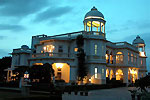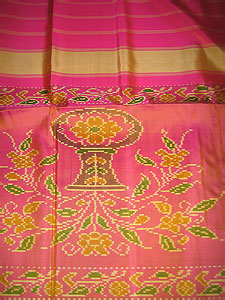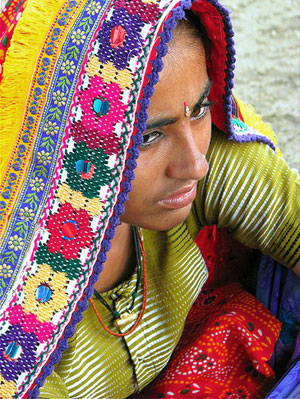|
|
| |
|
Gujarat Tours |
|
|
|
|
| |
|
|
| |
|
|
| |
|
|
| |
|
|
| |
|
|
| |
|
Gujarat Hotels |
|
|
 |
|
|
|
|
|
|
Handicrafts of
Gujarat |
|
|
Gujarat has a very rich
heritage of handicrafts. The handicrafts of Gujarat are very
unique. These handicrafts have been given a fillip by the
government and some private individuals. Craftsmen and women
who left their villages to work as stone crushers for the
living have been brought back to practise their traditional
arts. Their products can be seen and purchased in emporiums
in Gujarat, Delhi and Mumbai. The excavations at the
Harappan sites in Gujarat at Lothal, Rangpur, Rozdi etc.
have brought to light some of the very ancient handicraft
articles. Gujarat also has a rich tradition of embroidery,
leather work, bandhani and hand-block printing. Gujarat is
also known for the famous and unique Kutch embroidery.
|
|
|
|
Patola
The Patola of Patan is a unique fabric of Gujarat.
This special variety of women's wear is strikingly
attractive with its colourful geometrical patterns.
This lovely silken fabric, which resembles a printed
saree is not an apparel printed by blocks. Its tie and
weave method result in identical patterns on both
sides of the fabric, involving complicated designs,
and is entirely based on the geometry of the design.
The process consists of dyeing the warp and the weft
threads in conformity with the proposed design on the
fabric. Hand-woven and silk yarn is used for weaving.
The Patola silk sarees are extremely fine and quite
expensive and made by very small master craftsmen at
Patan.
Zari Work
The Zari or gold thread embroidery work of Surat is
one of the oldest handicrafts whose origin can be
traced back to the Mughal period. Surat is one of the
biggest and important Zari manufacturing centres in
India. The principal types of products are real gold
and silver threads, imitation gold and silver threads,
|
 |
|
|
embroidery such as Chalak,
Salama, Kangari, Tiki, Ring and Katori for motifying in the
Kinkhab and the Zari border weaving, laces, caps, turbans,
sarees, and blouse pieces. The Tanchoi or silk brocade is
woven on silk cloth and decorated with the designs of birds,
animals, leaves, fruits etc. The cloth is used for costly
sarees, blouses and tapestry. The Kinkhab or the Indian
brocade is woven on the silk with gold and silver threads.
Surat is also known for the Kinkhab gold brocades.
Dyeing
Dyeing is a hereditary art. In the past cloth was dyed in
colours extracted from trees and flowers. The Sarkhei suburb
of Ahmedabad was one of the indigo manufacturing and
exporting centres. The Bandhani, tie and dye variety of
saree is a very popular women's wear. It involves an
intricate process of tying knots on the fine white fabric,
which is dipped in colours. The hues of deeper shades are
used over the previous ones to form the coloured background
of the cloth.
Cloth printing
Cloth printing is a complicated and specialised job. It is
done with engraved wooden blocks and screens. Certain
craftsman are doing the work of printing different varieties
which are locally called Chundadi, Patola, Plain Gala,
Lehria, Bandhani, Pomcha, Nagaria. Household utility and
decorative materials such as table cloths, bed covers,
curtains, tapestries, hand bags and carpets are also
prepared by this type of printing process. The hand-painted
cloth is available in traditional black, red, maroon and
ochre colors and is also inexpensive. The tie-and-dye
fabrics are known all over the world for their variety and
excellent colors. Temple curtains popularly known as Mat-no-Chandarvo
is another type of printing work. The Vahari-Harijan
families of Ahmedabad were engaged in this type of printing.
It is prepared in the old process and depicts goddess Durga
seated on the throne or on the back of a tiger and
surrounded by her devotees.
Wood carving
Wood carving is an ancient art of the state which has
attained very high standard of technical skill. Some of the
best examples of wood-carvings are found in temples and
houses in many parts of Gujarat. The wood carvers produce
life-like figures of animals, artistic objects of every-day
use such as tea pots, table lamps, stools and toys for
children. Mahuva and Idar are famous for their lacquer toys.
Sankheda in Baroda district is known for its lacquer work.
The work is done on country-wood which gives darker shades.
The coating is done with fine lac. Women folk of Saurashtra
prepare idols, toys, ash-trays, toilet-boxes, lamp-stands
and flower-pots from the pulp of rags, banana stumps and
bamboos. Artistic Jars, water-pots and other utility
articled are prepared from clay. |
|
|
|
Embroidery
Embroidery has been a craft for women. Banni, a small
village in the Rann of Kutch is known for its artistic
embroidery work. Small mirrors are interspersed to
lend glitter and charm. The finest type of such
embroidery work with small mirrors is called
Abhla-Bharat. When a bride is sent to her husband's
house, she carries with her some pieces of skirts and
cholis exquisitely embroidered with minute details.
Inlay work
Ivory in Gujarat is mostly used in inlay work. Bangles
and sandal wood articles are inlaid with it.
Bead-work
Bead-work is a speciality of Rajkot, Bhavnagar,
Jamnagar and Junagadh. Decorative pieces like torans,
chopat, carpets, caps, and belts are some of the fine
articles of bead-work.
Jewellery
The art of making jewellery and precious stone-cutting
and processing is a traditional handicraft of Gujarat.
Gold smithy includes filigree-work, open- |
 |
|
|
wire-work, carving etc.
The folk jewellery of excellent designs, characteristic of
each village and each community is a typical art of Gujarat.
The silver craft is a specialty of Kutch, in which light
embossing is done on thin silver plates and is enhanced by
etching and scrapping. Attardanis, Gulsbdanis, Flower-vases,
trays, jewellery boxes, powder boxes, ash trays and
cigarette boxes are some of the articles of silver craft.
Agate is a semi-transparent mineral composed of quartz in
different colours and found in river beds. The raw stones
are processed by heating, chiselling, surfacing, polishing
and drilling before they are turned into artistic articles
such as ear-rings, necklaces, studs, bowls, and trays. The
industry is located in Cambay. |
|